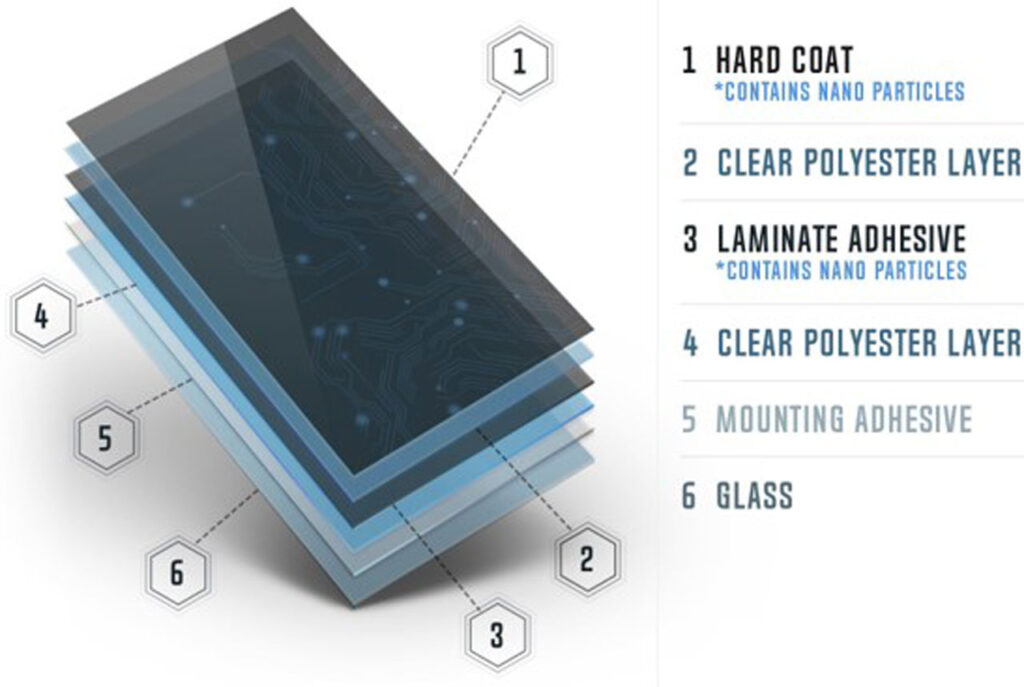
Table of Contents
There are various types of window tints available for cars, each serving different purposes. While some tints focus solely on aesthetics, others excel in providing excellent UV protection and infrared radiation blocking capabilities. Ceramic window tint stands out as the ultimate choice for superior window protection. Its advanced engineering ensures exceptional clarity while blocking an impressive 99.9 percent of UVA and UVB rays. Most importantly, it effectively reduces the interior heat of your vehicle, thanks to its infusion with IR blocking materials.
However, it’s important to note that ceramic film is a premium product, which means it comes with a higher price point compared to cheaper alternatives. Nevertheless, for car owners seeking top-notch interior protection, there are ceramic films available that offer great value for their investment.
Let’s delve into some of the key features and benefits of ceramic-infused window tinting solutions, with a closer look at Ceramic Pro’s latest offering – the KAVACA Ceramic IR Window Film.
What is the process involved in creating Ceramic Tint for Windows?
There are various grades of automotive window films available, with some of the most common options being:
Dyed Window Tint
This type of tint is manufactured using a polyester material infused with a liquid dye. The desired level of tint is achieved by applying the dye to the inner material. The darkness of the tint, often referred to as “limo tint,” is indicated by a lower VLT (Visible Light Transmission) rating. For instance, limo tint typically has a VLT rating of 5 percent, indicating a high level of darkness. However, it’s important to note that dyed tint may not be as effective in blocking UV ray emissions compared to other types of window tints.
Metalized Window Tint
Moving up the ladder, the next type of window film is the metallic tint. This variety contains metallic flakes, which play a crucial role in blocking harmful ultraviolet rays like UVA and UVB. These UV emissions can cause damage to various surfaces, including interior materials such as leather, plastic, rubber, and textiles. Notably, UVA and UVB exposure is also linked to the development of skin cancer. Moreover, a metalized window film offers an additional advantage by providing enhanced window strength, reducing the risk of shattering.
Hybrid Dye/Metallic Film
The mid-grade tint combines the finest features of dyed and metallic films, striking a balance between the two. This type of tint enhances UV protection while also optimizing clarity. Achieving this result, the hybrid tint utilizes a blend of grey dye and titanium flakes in its composition.
Carbon Color Stable
Introducing the latest addition to the window tint lineup: carbon color stable tint. This innovative option features a multi-layered dye film infused with carbon tint materials, providing added strength and durability throughout its lifecycle. The term “color stable” signifies the use of high-quality dyes and polyester linings, ensuring an extended lifespan and minimizing the risk of discoloration over time.
*Editor’s Note: Among the four tints mentioned earlier, a carbon window tint provides the most advantageous value.
Crystalline Window Tint
The crystalline-infused window tint serves as an entry point to enhanced heat resistance. Typically, this film boasts a high VLT rating, making it more transparent, while also featuring exceptional IR blocking technology. Its primary purpose is to minimize heat intrusion into the vehicle, rather than focusing on privacy or creating darker windows. Moreover, it is highly effective at blocking all ultraviolet rays, ensuring optimal UV protection.
Ceramic Window Tint
When it comes to ceramic-infused window tint, nanotechnology takes center stage. This advanced film consists of multiple layers, incorporating microscopic ceramic particles that are nonconductive, resulting in the blocking of nearly 99.9% of UVA and UVB rays. The absence of metals in the film not only enhances cell phone and electronic device signal strength but also contributes to its effectiveness in reducing heat infiltration into the vehicle. Moreover, when combined with IR blocking technology, the nano ceramic tint delivers remarkable heat reduction properties, further enhancing the overall comfort inside the vehicle.
Observe the attached image to get a visual insight into the design of this particular film type.

- The outermost layer, also known as the top coat, features nano particles that provide extra strength to the car window and reduce the likelihood of scratches.
- Directly beneath the top coat is a clear polyester layer, a simple, additive-free material that adds depth and thickness to the film.
- The laminate adhesive is where the real magic happens. Here, ceramic nano particles are blended to determine the VLT (visible light transmission) rating, resulting in improved visibility, even in dim lighting conditions. Many experts consider this enhanced visibility a significant improvement compared to lower-grade films.
- The last two layers consist of another clear polyester film (forming the ceramic sandwich) and the final mounting adhesive to complete the composition.
What advantages does a Ceramic Window Film offer?
When you choose a higher-grade product, you can expect it to come with superior qualities. This is particularly evident when comparing ceramic window tinting to regular tint options.
Superior UV Protection
UV and infrared rays pose significant risks and can lead to life-altering consequences. The sun emits various types of radiation, including Infrared Radiation (IR), responsible for generating heat, UVA, which penetrates deeply into tissues and materials, and UVB, which damages surface layers. Ceramic tint has the capability to block up to 99.9% of UV rays, offering effective protection against these harmful emissions.
Exceptional Heat Resistance
It’s fascinating to note that NASA’s Space Shuttle utilized ceramic tiles on its bottom to safeguard astronauts during re-entry. Although the IR emissions from the sun on Earth are not as extreme, the ceramic materials in this advanced window tint effectively block heat from entering the vehicle. Certain high-grade ceramic tints are even equipped with additional IR blocking technology, further enhancing their ability to resist heat.
Minimal Signal Interruption
Traditionally, higher-grade window tints in the past, with their enhanced ingredients, often came with certain drawbacks. The main concern was the blocking of cell or electronic signals, such as Bluetooth, Wi-Fi, or radio, usually due to the presence of metallic materials that added depth and strength. However, with the introduction of nano ceramic technology, this issue is eliminated, ensuring clear and uninterrupted phone calls.
Superior grade Ceramic IR window film incorporates ceramic nano particles that are non-metallic and non-conductive. It is specially designed to reflect a significant amount of UV and infrared heat while absorbing higher levels of light. This unique combination allows for maximum visibility and superior solar protection, similar to a professional-grade ceramic coating for windows.
Is investing in Ceramic Tint worth it?
When evaluating the cost-effectiveness of different automotive window films, ceramic film stands out as the best value for your money. Its benefits, such as improved infrared (IR) protection, minimized cell signal interference, and enhanced bonding capabilities for longer-lasting performance, make it a wise investment. In summary, opting for ceramic tint for your car proves to be a great choice in terms of durability and overall protection.
If you’ve been considering getting a ceramic window film installed on your vehicle, Ceramic Pro presents a groundbreaking solution for you. Introducing KAVACA CERAMIC IR, the ultimate Window Film that utilizes state-of-the-art nanoceramic technology with an IR layer. This innovative combination provides exceptional Heat Rejection, Glare Control, and UV protection, all without the use of metals, ensuring optimal signal clarity for your electronic devices.
With KAVACA Ceramic IR, you can customize your car with any of the 6 available shades, without compromising clarity or heat rejection with clear VLTs. Its advanced technology delivers a non-reflective, color-stable finish that remains vibrant over time.
Ceramic Pro boasts extensive expertise in vehicle and surface protection, and KAVACA Window Films are the result of meticulous research, offering both stunning aesthetics and high performance. If you want to explore more about our new line of window tints for cars or receive a free estimate from our certified installation centers, click the button below.
